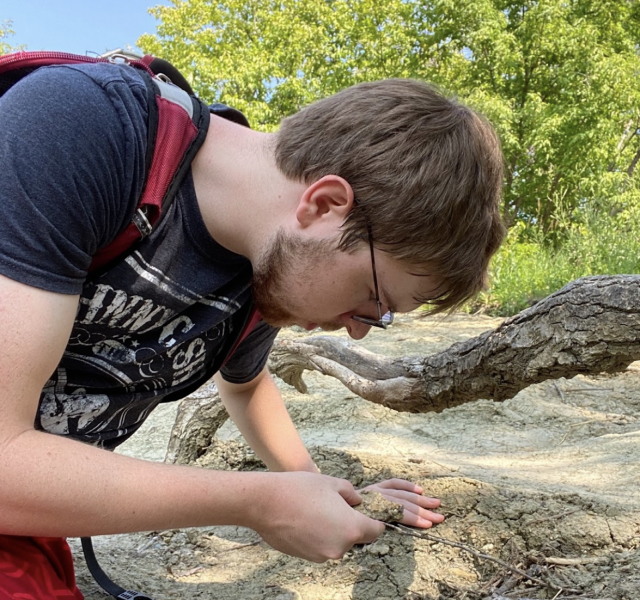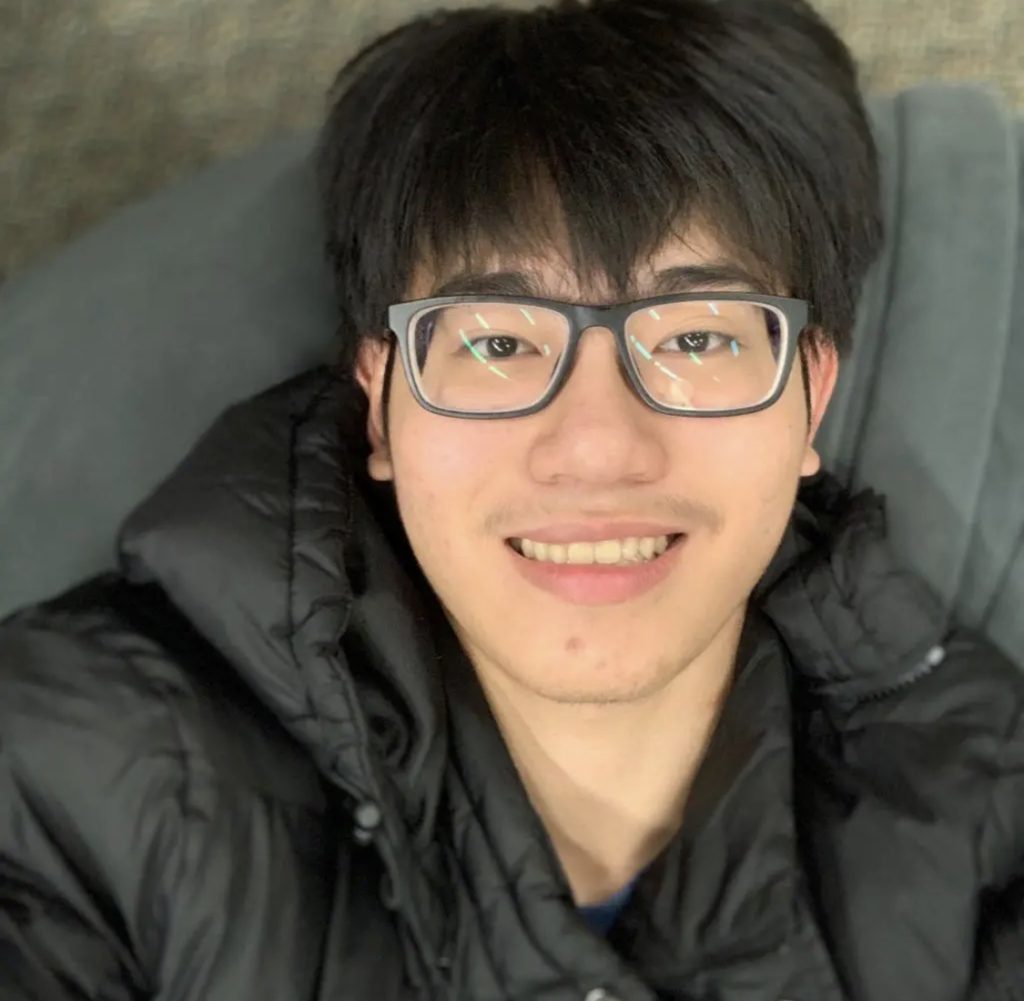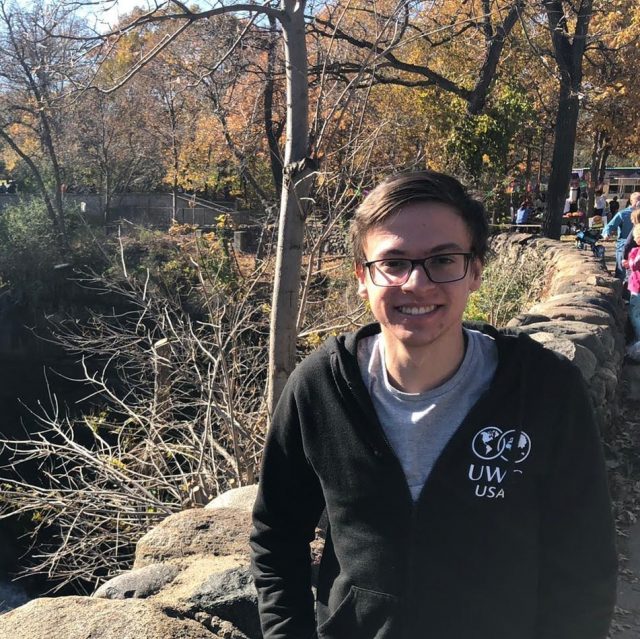
Working closely with Macalester’s professors happens in all departments at Macalester. From mapping bamboo forests with drones to researching education policies during a pandemic, ninety-six percent of students at Macalester engage in community-based learning, service, or applied research during their four years at 1600 grand.
Below are just a few of the projects that you’ll find students working on with professors in the sciences. Most students work on projects that professors have led for several years in the hopes of finding new discoveries and also to hone their skills as researchers. (Want to know about research projects at Macalester? Visit macalester.edu/summer-showcase.)

Studying Minnesota’s ocean-dwelling animals
“I used the scanning electron microscope and the micro-XRT to analyze the chemical composition of these unusual fossils.”
My work focused on more than one-hundred slabs of the Decorah shale that capture a community of ocean-dwelling animals that lived in Minnesota more than 400 million years ago. In my initial surveys of invertebrate diversity under a dissecting microscope, I noticed some weird fossils unlike anything I had seen before. I used the scanning electron microscope and the micro-XRT to analyze the chemical composition of these unusual fossils. Turns out that they are phosphatic chunks, which means they could be the bones of ancient back-boned animals!
My work continues, as I prospect for phosphate-rich fossils amidst the calcite skeletons of countless invertebrates on the slabs. I am documenting the occurrence and morphology of each phosphatic element in order to test the hypothesis that these fossils represent vertebrate skeletal elements. I am also distributing the data that I’ve taken and the descriptions I’ve made to experts in early vertebrates to hear their thoughts and see what their opinion is of these unusual fossils.
Logan McCutcheon ’22
Chicago, Illinois
Geology
Macalester Mentor(s): Professor Raymond Rogers, Professor Kristi Curry Rogers, Laboratory Supervisor Jeffrey Thole

Investigating neutrinos to explain how life exists
Professor Tonnis ter Veldhuis and I joined a scientific project that is probing the nature of neutrinos.
A neutrino is an elementary particle that is neutrally charged and has a mass so tiny that it was once thought to be massless. A neutrino only interacts via the weak force which has a very short range, and because of its small mass, interacts only negligibly via gravity. Therefore, it has been difficult to fully understand its nature, and research into this area is very active today.
We particularly look at ways to determine whether a neutrino is its own antiparticle or not. If it is found that a neutrino is its own antiparticle, it could pave a way for explaining why the universe has more matter than anti-matter, thereby allowing for life as we know it to exist. Since matter and anti-matter annihilate each other, if the universe has an equal amount of matter and anti-matter, then there would be nothing left but energy. So far, we have explored heavy neutrino decay, neutrino-neutrino oscillation, and neutrino-antineutrino oscillation, by focusing on a quantity called CP-violating phase, which basically quantifies such asymmetry in nature.
Chinhsan Sieng ’22
Cambodia
Physics, Mathematics
Macalester Mentor: Professor Tonnis ter Veldhuis
Quality care at Minnesota VA Medical Center
“We are currently working on a manuscript to get published in a medical journal.”
I worked on a quality improvement research project at the Minneapolis VA Medical Center. Our project examined the effectiveness of a novel treatment for prosthetic joint infections known as debridement, antibiotics, and implant retention (DAIR) paired with oral rifampin and another antibiotic, which has been used since the 1990s but has never been systematically investigated at the VA. We conducted a retrospective analysis of patients treated with DAIR and rifampin over the past twenty years.
We found an overall success rate of 82 percent, with a statistically significant difference in the success rate between participants with acute and non-acute infection onset. We also found multiple areas where the VA could improve its approach to treating prosthetic joint infections with rifampin. We are currently working on a manuscript to get published in a medical journal, and we have presented our findings to the ID staff to inform further practice.
Solana Cushing ’23
Minneapolis, Minnesota
Neuroscience
Macalester Mentor: Professor Jaine Strauss

Designing technology for everyone
“We made many improvements and fixed several bugs in the interface … to make it fully accessible and functional for people who use screen readers.”
This summer, I worked with Professor Lauren Milne and two other Macalester students to make Blockly more accessible for people who use screen readers. Blockly, a free and open-source Google project, is a library that represents coding concepts as blocks shaped like puzzle pieces. Instead of writing text, the user can manipulate and connect those graphic objects to create code. Since it does not require any knowledge of syntax or complex coding concepts, it is a great tool to teach programming to children. However, Blockly does not work well with screen readers, which prevents its use by children with vision impairments. For ten weeks, our research group helped translate the visual blocks to lines of text without loss of ease of use and block features. We made many improvements and fixed several bugs in the interface that previous research students had created, to make it fully accessible and functional for people who use screen readers. In addition, we designed tasks in which the user has to recreate nursery rhymes using our version of Blockly. While playing around with the nursery rhymes, children, regardless of disability, will be able to learn programming concepts, such as loops, conditional statements, and functions.
Macalester Mentor: Professor Lauren Milne
Copper and its role in neurodegenerative diseases
“This work will help inform studies for diseases caused by copper misregulation.”
I worked with Professor Kathryn Splan to analyze how copper interacts with zinc binding proteins. We studied a protein known as a “RING” domain, which has a large role in cellular protein regulation and may take part in copper homeostasis. Copper binding to the RING domain has not been well studied, hence the need for studies like this. This project’s greater impact gives basis to the molecular understanding in diseases that medical-scientists predict may be caused by excess copper due to misregulation.
The RING Domain has four zinc ions coordinated to it in its native state, and we show that when a substantial concentration of Cu(I) is introduced, the Zn(II) is released and copper becomes the new coordinated metal within the protein. Furthermore, we show that the disrupted protein has a change in structure, which also likely impacts its function. Together this work will help inform studies for diseases caused by copper misregulation.
Shreya Nagdev ’22
Pleasanton, California
Chemistry (Biochemistry)
Macalester Mentor: Professor Kathryn Splan
January 19 2022
Back to top




